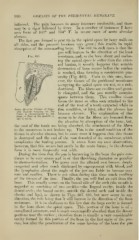Page 920 - My FlipBook
P. 920
930 DISEASES OF THE PERIDENTAL MEMBRANE.
inflamed, The pain becomes in many instances intolerable, and there
may be a rigor followed by fever. In a number of instances I have
seen fever of 103° and 104° F. in severe cases of acute alveolar
abscess.
The first pus farmed is pent up in the apical space by bony walls on
all sides, and the pressure becomes very great ; this results in rapid
absorption of the surrounding bone. The rule in such cases is that the
pus will burrow in the direction of the least
resistance, and, as the bone about and enclos-
ing the apical space is softer than the exter-
nal lamina, it usually happens that notable
destruction of bone occurs before the surface
is reached, thus forming a considerable pus-
cavity (Fig. 485). Even in this case, how-
ever, the tissues of the peridental membrane
occupying the apical space are not, as a rule,
destroyed. The fibres are swollen and great-
ly elongated, and the pus usually occupies
s])aces between them. This swollen tissue
forms the mass so often seen attached to the
end of the root of a tooth extracted while in
Acute Alveolar Abscess of Supe- this condition, or later, after the abscess has
rior lucisor puiutiug on the
Gum: ti, abscess-cavity in the become chronic. The explanation of this
bone ; ft, floor of the nostril ; c, seems to be that the fibres are loosened from
lip ; (/, tooth.
the alveolus by absorption of the bone, but,
the root of the tooth not being absorbed, the attachment of the fibres
to the cementum is not broken up. This is the usual condition of the
tissues in alveolar abscess, but in some cases it happens that this tissue
is destroyed and the end of the root denuded of its membrane, which
complicates the healing process. It seems from my own observation,
however, that this occurs but rarely in the acute forms ; in the chronic
form it is more frequently met with.
During the time that the pus is burrowing in the bone the pain con-
tinues to be very severe and is of that throbbing character so peculiar
to abscess-formation. The gums over the affected root become deeply
congested and often much thickened by engorgement with blood, and
the lymphatics about the angle of the jaw are liable to become very
sore and swollen. There is not often during this time much swelling
of the tissues of the face. Finally, the pus will find an exit from the
bone. This usually occurs on the buccal side of the arch (the mouth is
regarded as consisting of two cavities—the lingual cavity, inside the
dental arch ; the buccal cavity, outside the dental arch and inside the
checks and lips), as shown in Figs. 485, 486, but may occur in any
direction, the rule being that it will burrow in the direction of the least
resistance. It is in obedience to this law that the large cavity is formed
in the bone about the apical space. This portion of the bone is of a
cancellated structure, and is much more raj)idly absorbed than the denser
portions near the surface ; therefore there is usually a very considerable
cavity formed in this portion of the bone in the ifirst stage of the pro-
cess, but after the penetration of the outer lamina of the bone the pus


